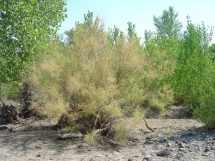Overview
The plants are considered to be among the world’s 100 top invaders and one of the most damaging invasive weeds in the western US. The species that are present in the U.S. include Tamarix ramosissima, T. parviflora, T. aphylla, T. chinensis, and T. canariensis, and several hybrid forms between the different species (Gaskin & Schaal 2002). Similar to Arundo donax (giant reed), tamarisk invades riparian systems and responds positively to flooding which seems to facilitate establishment. The plants form dense stands, and invaded areas often become completely dominated by tamarisk with few other plant species present.
Origin
Introduction
Tamarisks are small trees or shrubs native to Eurasia that were introduced into western North America in the mid 1800’s, mainly to provide windbreaks and to prevent soil erosion in semi-arid and arid areas. The plants became naturalized in late 1800’s (Shafroth et al. 2005), and some species are still planted as ornamentals and shade trees. Approximately 1-1.6 million hectares of land in North America is infested today (Shafroth et al. 2005). This dense shrub lives up to approximately 100 years, can grow up to 30 feet tall and has a root depth of up to 30 feet. This root depth is roughly twice the depth of cottonwood roots - allowing displacement in areas with fewer shallow water sources and deeper groundwater sources.
Tamarisk Species - (PDF Handout)
Tamarix ramosissima
T. chinensis
T. parviflora
T. aphylla
T. canariensis
Ecological Effects
Native Systems.
- Displaces native riparian plants like cottonwoods and willows, and mesquites in drier areas
- Provides poor habitat for birds, amphibians and other wildlife, and poor forage for livestock
- Narrows stream channels and promotes erosion
- Restricts recreational access
Water. Tamarisk not only consumes an abundant amount of water due to its excessive evapotranspiration, but also distributes salt along the ground, increasing soil salinity. Tamarisk is often reported to be more drought tolerant than native cottonwood or willow vegetation. According to one assessment, the Colorado River Basin, could recover over 840,000 acre-feet of water per year after saltcedar eradication and re-vegetation.
Fire. Fire and Tamarisk have a positive feedback loop, thus increasing the susceptibility of riparian areas. Tamarisk is readily flammable even when healthy and green, increasing the incidence of wildfers, but tamarisk is then able to recover and dominate a recently burned area. This is of concern for the surrounding development as well as the potentially negatively impacted economy. Repeated biocontrol (over 5 years) can reduce the Tamarisk volume and related fire hazard.
Wildlife. Tamarisk not only provides poor habitat to wildlife, with plant-feeding wildlife avoiding the species, but also replaces native wildlife-supporting riparian vegetation such as the Fremont cottonwood (Populus fremontii) and the Goodding’s willow (Salix gooddingii).
Avian. Due to the invasive tamarisk displacing better suited native vegetation for the SWFL to use as habitat, tamarisk is now used by the endangered bird species as nesting habitat.
Sediment. Tamarisk also acts as a positive feedback with flooding. The species was initially introduced in the 1900s to aid in flood prevention and successfully decreases sediment load to rivers. Due to the decreased sediment load, active river channels are narrowing, resulting in an increase in flooding along the flood plain as water is more likely to overflow. The seed-release timing of tamarisk extends into summer when monsoon-related floods help the seeds travel to fresh surfaces in some areas. The seed-release timing of tamarisk allows seeds germinate from spring to fall -- this extended timing corresponds with monsoon-related floods, helping the seeds travel to fresh surfaces in some areas with germination occurring quickly after becoming wet and leading to quick establishment after floods.
Potential Control
Tamarisk has proven extremely difficult and labor intensive to control with mechanical and chemical methods. Consequently, a tamarisk biocontrol program was initiated in the 1960’s. In North America, the plants are subject to very little herbivory. As with many introduced plant species, the full suit of plant feeding insects and pathogens that may feed on the plants in the native ranges was not imported at the time of introduction.
After extensive exploration of potential biocontrol agents in the plants native ranges (Europe, Asia and North Africa), and subsequent testing to ensure safety and efficacy (e.g. DeLoach et al. 2000, DeLoach et al. 2003, Lewis et al. 2003, Dudley & Kazmer 2005), the leaf beetle Diorhabda elongata (Coleoptera: Chrysomelidae) was released into the open in 2001. The results of these releases were mixed (DeLoach et al. 2004), and the most successful establishment took place at five sites in Colorado, Nevada, Utah and Wyoming.
At sites in northern Nevada, the beetles have defoliated vast stands with over 10 000 ha damaged at one site in 2004 (Geraci et al. 2006). By the 4th year of defoliation (2005), plant mortality reached 40%. Even without plant mortality, biocontrol may provide substantial benefits. Sap-flow measurements and evapotranspiration indicated that groundwater losses were reduced by over 70% during the first year of defoliation in Nevada, with greater savings in subsequent years (Pattisson et al.; unpubl. data). In addition, recent studies suggest that both avian (Hitchcock et al.; in review) and spider (Dalin & Dudley; unpubl. data) diversity and abundance have increased in stands where D. elongata is present.




 Defoliated tamarisk
Defoliated tamarisk Regrowth of tamarisk in Sonoran Desert
Regrowth of tamarisk in Sonoran Desert